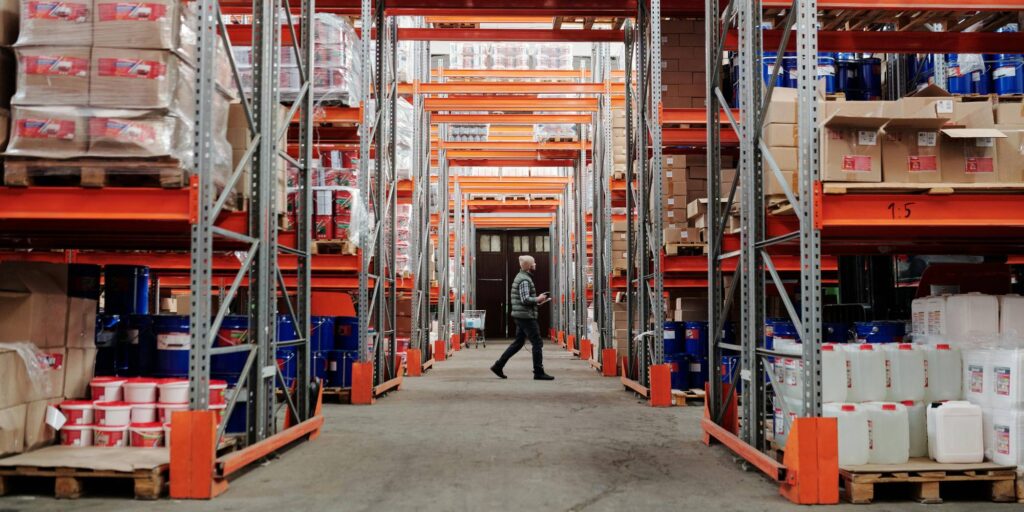Efficient warehouse operations are vital for any business that manages logistics, inventory, or product distribution. An optimized warehouse directly contributes to faster delivery times, reduced operational costs, and better customer satisfaction. Here’s a step-by-step approach to improving warehouse operations, offering proven methods to enhance productivity and streamline internal systems.
Table of Contents
Key Takeaways✔ Map all warehouse workflows to uncover inefficiencies across receiving, storage, picking, and shipping processes. ✔ Set clear, measurable goals using SMART criteria and relevant KPIs to guide and track warehouse improvements. ✔ Redesign layout for efficiency by creating functional zones, optimizing flow, and maximizing vertical space. ✔ Modernize inventory management with cycle counting, barcode or RFID systems, and ABC inventory classification. ✔ Deploy a warehouse management system to centralize inventory control, automate order flow, and improve labor use. ✔ Optimize picking and packing with tailored strategies, standardized materials, and enabling technologies like scanners. ✔ Automate strategic tasks such as sorting and palletizing to increase speed, reduce errors, and free up labor. ✔ Train and empower employees through structured onboarding, cross-training, and participation in process improvement. ✔ Prioritize safety and compliance by conducting audits, enforcing OSHA standards, and integrating safety into daily routines. ✔ Continuously monitor and adjust performance using real-time data, SOP refinement, and feedback-driven changes. |

Step 1: Analyze Current Warehouse Workflows
The foundation of any warehouse process improvement initiative is a thorough analysis of existing workflows. Without a clear picture of how goods and information move through the facility, it’s nearly impossible to identify where inefficiencies are hiding. These detailed evaluations not only bring clarity to warehouse operations but also prepare the organization to implement scalable warehouse improvement ideas in the next phases.
Start by mapping out the entire workflow:
- Inbound logistics: Evaluate how inventory is received, inspected, and logged. Delays here can ripple through the entire operation.
- Storage patterns: Document where items are stored and how they’re organized. Poor storage logic often leads to unnecessary search time.
- Picking and packing procedures: Track how orders are fulfilled, packaged, and moved to shipping. These are high-labor areas with frequent optimization opportunities.
- Outbound logistics: Review how shipments are prepared, labeled, and loaded. Late-stage errors can undo earlier efficiencies.
Key data points to collect:
- Order accuracy rate: High error rates often signal process gaps or training issues.
- Pick and pack cycle time: Helps isolate slow areas within the workflow.
- Inventory turnover and restocking frequency: Indicates how well stock levels are managed.
Conduct on-the-floor observations:
- Shadow staff across shifts to identify patterns in delays or unnecessary movement.
- Interview employees to understand workflow frustrations and suggestions.
Visualize bottlenecks with tools like:
- Spaghetti diagrams to track movement and identify inefficiencies.
- Heatmaps showing which warehouse zones experience the most congestion or delays.
Step 2: Set Specific Operational Goals
Once a performance baseline is established, the focus should shift to setting precise and results-driven objectives. These goals should address the weaknesses discovered during workflow analysis and support broader business outcomes. Goals provide direction, inspire accountability, and fuel momentum in improving warehouse operations.
Examples of useful KPIs:
- Inventory accuracy rate: Measures the reliability of stock data.
- Average order picking time: Assesses labor efficiency.
- On-time shipment percentage: Reflects end-to-end operational reliability.
- Space utilization ratio: Helps determine if storage areas are optimized or overcrowded.
How to structure goals effectively:
- Use the SMART goal framework:
- Specific: Target a clear issue (e.g., reduce picking time).
- Measurable: Assign a metric (e.g., 20% decrease).
- Achievable: Ensure it’s within your team’s capacity.
- Relevant: Align with business goals.
- Time-bound: Define a deadline (e.g., within 3 months).
Benefits of structured goal-setting:
- Drives continuous warehouse process improvement.
- Enables staff to prioritize high-impact changes.
- Establishes a clear metric for success tracking.

Step 3: Optimize Warehouse Layout and Space Utilization
According to a 2024 industry report, 74% of warehouse professionals report space utilization issues, and 71% struggle with inventory control. These widespread challenges highlight the importance of reevaluating layout strategies and storage logic to support scalable warehouse process improvement. An optimized warehouse layout can dramatically improve speed, safety, and space efficiency.
Divide the warehouse into functional zones:
- Receiving: Allocate enough space for incoming goods without blocking aisles.
- Storage: Organize by product velocity or SKU category to reduce travel time.
- Picking: Design routes for minimal backtracking.
- Packing: Provide clean, well-stocked stations for efficiency.
- Shipping: Ensure easy dock access and clear staging zones.
Implement layout enhancements:
- Slot fast-moving items closer to pick zones: Reduces travel distance and increases picking speed.
- Use vertical space: Install racking systems, mezzanines, or vertical lift modules to maximize cubic footage.
- Optimize aisle width: Strike a balance between space for equipment and space for inventory.
- Design with flow in mind: Arrange zones in a logical sequence from receiving to shipping, avoiding unnecessary back-and-forth.
Tools to assist layout planning:
- CAD software for space modeling and simulations.
- Lean 5S principles to maintain order and cleanliness: Sort, Set in Order, Shine, Standardize, Sustain.
Why layout matters for warehouse process improvement:
- Minimizes wasted motion and worker fatigue.
- Enhances safety by reducing cross-traffic and clutter.
- Supports higher daily throughput with the same resources.
Step 4: Upgrade Your Inventory Management Practices
Inventory management plays a critical role in warehouse process improvement. Even small inaccuracies in inventory records can result in order errors, delays, and loss of customer trust. Streamlining inventory processes ensures accuracy, efficiency, and adaptability in every warehouse operation.
Improving warehouse operations through modern inventory techniques reduces financial waste, boosts order fulfillment reliability, and provides a stronger foundation for scalable warehouse improvement ideas.
Strategies include:
- Ditch annual physical counts: These are time-consuming, prone to error, and disruptive. Instead, cycle counting allows inventory to be checked regularly in small sections without interrupting daily operations.
- Use barcode and RFID technology: These tools automate data capture, reduce manual entry errors, and enhance traceability of goods within the facility.
- Apply inventory classification methods – ABC Analysis:
- A-items: High value, low quantity — prioritize tracking.
- B-items: Moderate value and frequency.
- C-items: Low value, high quantity — automate where possible.
- Introduce inventory zoning: Group products based on demand frequency, size, and shipping patterns. This shortens travel time and boosts picking accuracy.
- Enable cross-functional forecasting: Real-time inventory control supports better purchasing decisions, improved demand planning, and lower carrying costs.

Step 5: Implement a Warehouse Management System (WMS)
A Warehouse Management System is a cornerstone for digital transformation in logistics. With automation and precision, a WMS is among the most impactful warehouse improvement ideas for long-term scalability and control. In fact, a recent report found that 70% of supply chain leaders plan to replace or upgrade their WMS within the next 12 months to enhance tracking, automation, and overall efficiency.
Core benefits of a WMS:
- Centralized inventory control: Tracks stock levels, locations, and movements with pinpoint accuracy.
- Order management automation: Coordinates order picking, packing, and shipping efficiently.
- Labor tracking and optimization: Assigns tasks based on worker availability and performance, reducing idle time.
Types of WMS solutions:
- Standalone WMS: Ideal for small to mid-sized businesses. Provides robust functionality with limited integration.
- ERP-integrated WMS: Best for large-scale or multi-site operations. Combines warehouse operations with financial, HR, and customer data for seamless reporting.
Important implementation steps:
- Pilot the system with a single process or department: Minimizes disruption and allows time for refinement.
- Train staff thoroughly: Workers must understand system workflows, device usage, and troubleshooting basics.
- Integrate gradually: Avoid sudden full-scale rollout. A phased approach ensures each component is functioning correctly.
Why a WMS supports improving warehouse operations:
- It eliminates manual tracking spreadsheets.
- It reduces delays caused by lost or misplaced items.
- It creates consistent performance standards across all warehouse operations.
Step 6: Streamline Order Picking and Packing Processes
Picking and packing consume a significant share of labor and time within a warehouse operation. Improving efficiency in these areas directly increases order fulfillment speed and customer satisfaction. Streamlined picking and packing systems are key warehouse improvement ideas that translate directly into faster service and better profit margins.
Choose the right picking method based on your needs:
- Zone Picking: Workers are assigned to specific zones and pick only items within that area. Reduces worker movement and supports parallel picking.
- Batch Picking: Multiple orders are picked in one run to minimize trips to the same area. Ideal for high-volume operations.
- Wave Picking: Orders are grouped by delivery time or carrier. Workers pick in waves, improving shipping coordination.
- Pick-to-Light: Light indicators guide workers to the correct bins. Increases accuracy and reduces training time.
Packing process enhancements:
- Use standardized materials: Keeps packing consistent and prevents damage in transit.
- Create dedicated packing stations: Equip them with necessary tools, such as tape dispensers, labels, and padding, to minimize walking and delays.
- Implement quality checks before sealing: Reduces returns caused by incomplete or incorrect orders.
Introduce enabling technologies:
- Handheld scanners: Speed up item verification and reduce errors.
- Voice-picking systems: Allow hands-free operation for faster processing.
- Wearables: Improve navigation and task tracking, especially in large facilities.
Step 7: Automate Where It Makes Sense
Automation is a strategic component of warehouse process improvement—but it’s not a one-size-fits-all solution. Businesses must weigh cost, scalability, and relevance before automating. When thoughtfully implemented, automation strengthens improving warehouse operations by enhancing throughput, reducing human error, and optimizing resource allocation.
Begin by identifying areas best suited for automation:
- High-volume tasks: Repetitive actions like sorting, labeling, or stacking.
- Time-sensitive processes: Steps where speed directly impacts delivery times.
- Error-prone functions: Tasks that involve frequent manual data entry or sorting.
Common automation technologies in a warehouse operation:
- Conveyor Systems: Move goods efficiently between zones, minimizing walking and manual transfers.
- Automated Guided Vehicles (AGVs): Transport items autonomously, freeing workers for complex tasks.
- Sortation Machines: Categorize packages by size, destination, or order priority with high speed and accuracy.
- Robotic Palletizers: Automate pallet stacking, reducing strain and injury risk in high-volume shipping areas.
Additional tools gaining traction:
- Automated storage and retrieval systems (AS/RS): Retrieve inventory from vertical storage units with speed and precision.
- Drones: Scan inventory in tall racking systems, reducing the need for ladders or lifts.
- Pick robots: Handle individual SKUs in e-commerce settings with minimal human input.
Practical warehouse improvement ideas for smaller budgets:
- Partial automation: Introduce single-function machines (e.g., label printers or carton erectors) to improve individual processes.
- Modular systems: Allow for future scalability without heavy upfront investment.
Best practices for automation rollout:
- Start with pilot testing in low-risk areas.
- Train staff to work alongside automation to reduce fear or resistance.
- Monitor metrics to assess ROI and make iterative improvements.

Step 8: Train and Empower Your Warehouse Staff
No amount of automation or software can substitute for a well-trained, engaged workforce. Human performance remains the heart of warehouse process improvement. A warehouse operation thrives when employees are equipped with skills, given room to grow, and made part of the improvement process.
Why training is critical:
- Technology adoption: Workers must be comfortable using new systems and interfaces.
- Consistency: Standardized training ensures tasks are completed the same way across shifts and locations.
- Error reduction: Clear instruction minimizes order inaccuracies and safety violations.
Key training practices:
- Onboarding programs: Introduce new hires to safety, technology, and workflow expectations from day one.
- Role-based modules: Customize training for forklift operators, pickers, supervisors, etc.
- Refresher sessions: Reinforce best practices regularly, especially after process changes.
Empower staff with expanded capabilities:
- Cross-training: Prepares employees to fill in during absences or high-demand periods. Increases workforce versatility and reduces bottlenecks.
- Certifications and upskilling: Offer incentives for learning new tools or equipment. Builds morale and supports employee retention.
- Recognition and feedback loops: Encourage team members to share process improvement ideas. Recognize contributions that improve the warehouse operation’s performance.
Step 9: Prioritize Safety and Compliance
Warehouse environments can be physically demanding and potentially hazardous. That makes safety not only a legal obligation but a critical factor in warehouse process improvement. By making safety an ongoing initiative—rather than a one-time checklist—organizations reduce accidents, protect morale, and reinforce their commitment to improving warehouse operations in a holistic way.
Perform regular safety audits:
- Inspect walkways and aisles: Ensure they’re clear of obstructions and appropriately marked.
- Check lighting and signage: Poor visibility contributes to accidents. Make sure signs are legible and placed strategically.
- Assess equipment and racking systems: Ensure forklifts, shelving, and ladders meet operational standards.
Conduct ergonomic evaluations:
- Workstation layout: Ensure items are within reach to reduce overexertion.
- Material handling aids: Use lifts, carts, or hoists to minimize manual lifting.
Ensure compliance with safety standards:
- OSHA regulations: Maintain documentation, display required signage, and train on hazard communication.
- PPE usage: Reinforce the use of gloves, helmets, eye protection, or hearing aids where applicable.
- Fire safety protocols: Ensure exits are accessible, alarms are functional, and fire extinguishers are routinely inspected.
Step 10: Monitor Performance and Adjust Continuously
Improving warehouse operations is an ongoing cycle of measurement, analysis, and refinement. Continuous performance monitoring allows teams to catch problems early, validate improvements, and stay competitive in a changing environment. Embedding a mindset of continuous improvement ensures that businesses sustain and evolve them. That’s what truly defines success in improving warehouse operations over the long term.
Use data-driven monitoring tools:
- Dashboards: Display real-time metrics to give managers instant visibility into daily performance.
- Automated reporting systems: Generate scheduled summaries of KPIs, allowing leadership to compare trends over time.
- Mobile apps and handheld devices: Enable on-floor supervisors to access live data while managing operations in real-time.
Track the right performance indicators:
- Order Cycle Time: Measures how long it takes from order receipt to shipping—critical for assessing fulfillment speed.
- Picking Accuracy/Error Rates: Identifies quality control issues and staff training needs.
- Labor Productivity: Tracks output per worker or team, helping to balance workloads and identify top performers.
- Inventory Turnover and Stock Levels: Reveals whether items are overstocked or understocked, informing procurement and stocking decisions.
Schedule regular performance reviews:
- Daily huddles: Quickly highlight yesterday’s successes and flag today’s challenges.
- Weekly team reviews: Evaluate broader trends and discuss minor workflow adjustments.
- Monthly strategy sessions: Align team performance with organizational goals and identify areas for larger-scale improvements.
Refine Standard Operating Procedures (SOPs) based on insights:
- Update workflows that consistently underperform.
- Retire outdated steps that no longer serve the warehouse operation.
- Document and scale up any successful test initiatives.
Encourage a feedback-driven culture:
- Allow frontline workers to share observations: Their daily experience can expose gaps that data may not show.
- Test small changes before full implementation: Pilot programs reduce risk and provide proof of concept.
Reward proactive improvements: Recognize team members who initiate or contribute to meaningful warehouse improvement ideas.
Frequently Asked Questions
To improve warehouse operations, start by analyzing workflows, setting performance goals, and optimizing layout and space usage. Implement modern inventory management practices and automation where applicable. Regular staff training and continuous performance monitoring also help drive long-term efficiency.
The six basic warehouse operations are receiving, put-away, storage, picking, packing, and shipping. Each function plays a crucial role in the overall flow and efficiency of a warehouse. Optimizing these steps ensures smoother operations and better order fulfillment.
The five common wastes are excess inventory, unnecessary motion, waiting time, overprocessing, and defects. These inefficiencies increase costs and reduce productivity. Identifying and eliminating them is key to effective warehouse process improvement.
ABC warehouse operations use the ABC inventory classification method to prioritize stock based on value and usage frequency. “A” items are high-value and require tight control, “B” items are moderate, and “C” items are low-value but high-volume. This system improves inventory management and picking efficiency.
Efficiency can be improved by redesigning lathe yout, using barcode/RFID systems, implementing a warehouse management system, streamlining picking methods, and training staff. These steps reduce errors and increase speed in daily operations. Together, they form a strong foundation for improving warehouse operations.

Optimize Your Warehouse Operations with 3PL Warehouse by Best
If you’re looking to streamline your logistics and scale operations effectively, partner with 3PL Warehouse By Best, the trusted name in warehouse solutions. Based in New York, NY, 3PL Warehouse By Best specializes in third-party logistics tailored to your business needs. With cutting-edge technology and a commitment to excellence, 3PL Warehouse By Best ensures fast, accurate, and flexible warehousing services.
Contact 3PL Warehouse By Best in New York, NY, today and discover how professional third-party logistics can transform your warehouse operations!

